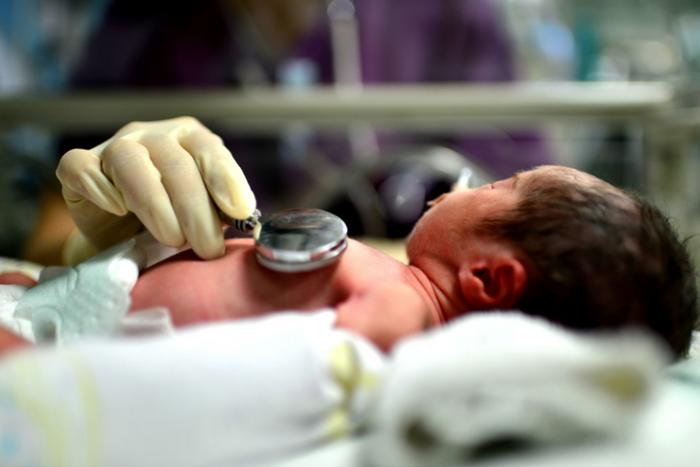Umbilical venous catheterization (UVC) is vital in neonatal care, as it provides essential intravenous access for preterm infants in neonatal intensive care units (NICUs). However, UVC is also associated with some risks, like catheter-associated infections, with central line-associated bloodstream infection (CLABSI) being a prominent concern. The incidence of UVC-associated CLABSI varies widely, and the optimal dwell time for UVC remains uncertain. While some reports suggest that early removal of the catheter followed by placement of a peripherally inserted central-line catheter can mitigate CLABSI risk, the data seems insufficient to draw any conclusions. CLABSI not only poses immediate health threats but can also lead to long-term consequences, including impaired neurodevelopment in preterm infants, highlighting the need for evidence-based national guidelines.

Credit: Prof. Mingyan Hei from Beijing Children’s Hospital, Capital Medical University
Umbilical venous catheterization (UVC) is vital in neonatal care, as it provides essential intravenous access for preterm infants in neonatal intensive care units (NICUs). However, UVC is also associated with some risks, like catheter-associated infections, with central line-associated bloodstream infection (CLABSI) being a prominent concern. The incidence of UVC-associated CLABSI varies widely, and the optimal dwell time for UVC remains uncertain. While some reports suggest that early removal of the catheter followed by placement of a peripherally inserted central-line catheter can mitigate CLABSI risk, the data seems insufficient to draw any conclusions. CLABSI not only poses immediate health threats but can also lead to long-term consequences, including impaired neurodevelopment in preterm infants, highlighting the need for evidence-based national guidelines.
Recognizing the vital need to mitigate this risk, researchers undertook a comprehensive study to investigate the dwell time and incidence of CLABSI associated with UVC in China. The study, led by Professor Mingyan Hei from Beijing Children’s Hospital, Capital Medical University, was conducted from November 2019 to August 2021 and included 2,172 preterm infants with UVC. “To our knowledge, this is the first national-level study on UV catheter dwell time and CLABSI incidence in China” claimed Prof. Hei. This study was published in volume 7, issue 3 of Pediatric Investigation on 15th October 2023.
Among infants aged 30.0 weeks on average, with a median birth weight of 1258.5 grams, the median UVC dwell time has been found to be 7 days. “Though we found the same increasing trend of the incidence of UVC-associated CLABSI when the dwell time increases, as in previous studies, our study showed no significant difference in CLABSI incidence between 0-7 days and 7-15 days of dwell time under the current status of UVC management in China. This might have been due to the high exposure rate of antibiotics among preterm infants in China” says Prof. Hei. The study also found that a high rate of antibiotic exposure did not cause any reduction in CLABSI rates, raising questions about the efficacy of antibiotics in preventing these infections. The study’s findings underscore the complexity of neonatal care, emphasizing the need for nuanced approaches in antibiotic administration.
Additionally, the research highlighted the top complications associated with UVC, with catheter occlusion and migration of the UVC tip being the most prevalent. These insights are crucial for healthcare providers, allowing them to anticipate challenges and optimize care strategies for neonatal patients.
One of the study’s most significant contributions is its national scope. By encompassing a vast array of NICUs across different provinces, this study provides a comprehensive overview of UVC practices and complications in China. The findings not only benefit the medical community but also serve as a reference for policymakers and healthcare administrators, guiding the formulation of standardized protocols for UVC procedures in NICUs nationwide.
While this study provides crucial insights, it also raises pertinent questions for future research. As the healthcare landscape evolves, further studies are warranted to delve deeper into the complexities of neonatal care, including the impact of antibiotics, optimal dwell times, and long-term outcomes for preterm infants undergoing UVC procedures. With its illumination of UVC practices in China and challenge to conventional wisdom, this national study lays the groundwork for evidence-based improvements in neonatal healthcare.
***
Reference
DOI: https://doi.org/10.1002/ped4.12403
Authors: Xu Zheng1 Dan He2 Zixin Yang1 Lu Chen1 Min Jiang1 Yujie Qi1 Fei Qin1 Jie Yu1 Yaguang Peng3 Ling Liu2 Mingyan Hei1,4
Affiliations
1Neonatal Center, Beijing Children’s Hospital, Capital Medical University, National Center of Children’s Health, Beijing, China
2Guiyang Maternal and Child Health Care Hospital, Guiyang Children’s Hospital, Guizhou, China
3 Center for Clinical Epidemiology and Evidence-based Medicine, Beijing Children’s Hospital, Capital Medical University, National Center for Children’s Health, Beijing, China
4 Key Laboratory of Major Diseases in Children, Ministry of Education, Beijing, China
About Professor Mingyan Hei
Professor Mingyan Hei is a renowned expert in the field of neonatology and holds a Doctorate. She is affiliated with Beijing Children’s Hospital, Capital Medical University, and is the director of the Neonatal Center. Professor Hei’s work is invaluable in advancing the understanding and treatment of neonatal health, making her an esteemed figure in the medical community, particularly in Beijing, China. Her dedication to improving child health is evident in her extensive body of work.
Your Press Release Source:
Pediatric Investigation
Twitter: https://twitter.com/pediatrinvestig
Journal
Pediatric Investigation
DOI
10.1002/ped4.12403
Method of Research
Observational study
Subject of Research
People
Article Title
Dwell time and bloodstream infection incidence of umbilical venous catheterization in China
Article Publication Date
15-Oct-2023
COI Statement
The authors declare no conflict of interest.




